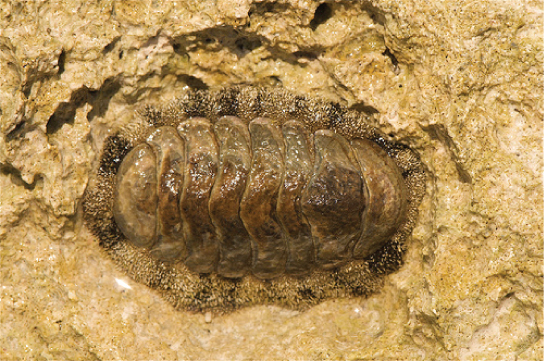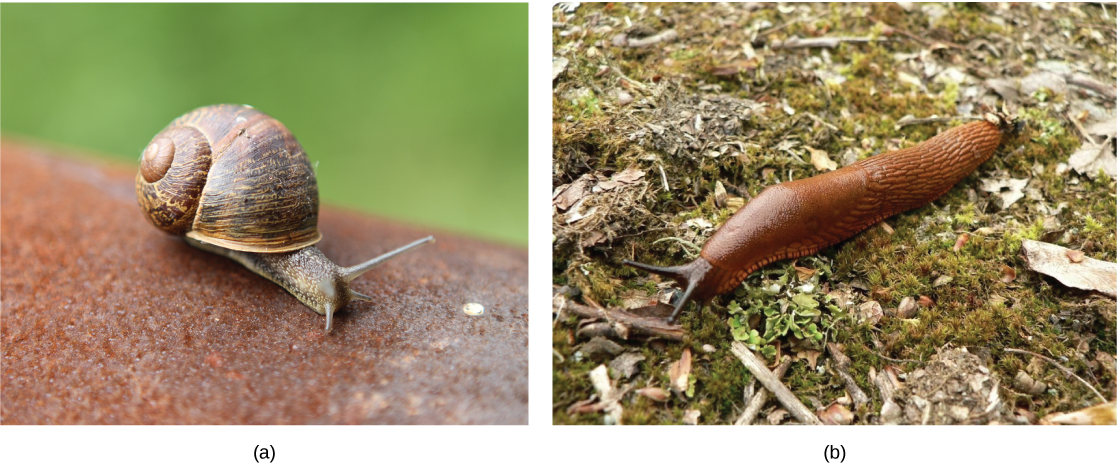| << Chapter < Page | Chapter >> Page > |
This phylum is comprised of seven classes: Aplacophora, Monoplacophora, Polyplacophora, Bivalvia, Gastropoda, Cephalopoda, and Scaphopoda.
Class Aplacophora (“bearing no plates”) includes worm-like animals living mostly on deep ocean bottoms. These animals lack a shell but have aragonite spicules on their skin. Members of class Monoplacophora (“bearing one plate”) have a single, cap-like shell enclosing the body. The monoplacophorans were believed extinct and only known as fossils until the discovery of Neopilina galatheae in 1952. Today, scientists have identified nearly two dozen living species.
Animals in the class Polyplacophora (“bearing many plates”) are commonly known as “chitons” and bear an armor-like, eight-plated shell ( [link] ). These animals have a broad, ventral foot that is adapted for attachment to rocks and a mantle that extends beyond the shell in the form of a girdle. They breathe with ctenidia (gills) present ventrally. These animals have a radula modified for scraping. A single pair of nephridia for excretion is present.

Class Bivalvia (“two shells”) includes clams, oysters, mussels, scallops, and geoducks. They are found in marine and freshwater habitats. As the name suggests, bivalves are enclosed in a pair of shells (or valves) that are hinged at the dorsal side. The body is flattened on the sides. They feed by filtering particles from water and a radula is absent. They exchange gases using a pair of ctenidia, and excretion and osmoregulation are carried out by a pair of nephridia. In some species, the posterior edges of the mantle may fuse to form two siphons that inhale and exhale water. Some bivalves like oysters and mussels have the unique ability to secrete and deposit a calcareous nacre or “mother of pearl” around foreign particles that enter the mantle cavity. This property is commercially exploited to produce pearls.
Gastropods (“stomach foot”) include well-known mollusks like snails, slugs, conchs, sea hares, and sea butterflies. Gastropods include shell-bearing species as well as species with a reduced shell. These animals are asymmetrical and usually present a coiled shell ( [link] ).

The visceral mass in the shelled species is characteristically twisted and the foot is modified for crawling. Most gastropods bear a head with tentacles that support eyes. A complex radula is used to scrape food particles from the substrate. The mantle cavity encloses the ctenidia as well as a pair of nephridia.
The class Cephalopoda (“head foot” animals) includes octopuses, squids, cuttlefish, and nautilus. Cephalopods include shelled and reduced-shell groups. They display vivid coloration, typically seen in squids and octopuses, which is used for camouflage. The ability of some octopuses to rapidly adjust their colors to mimic a background pattern or to startle a predator is one of the more awe-inspiring feats of these animals. All animals in this class are predators and have beak-like jaws. All cephalopods have a well-developed nervous system, complex eyes, and a closed circulatory system. The foot is lobed and developed into tentacles and a funnel, which is used for locomotion. Suckers are present on the tentacles in octopuses and squid. Ctenidia are enclosed in a large mantle cavity and are serviced by large blood vessels, each with its own heart.

Notification Switch
Would you like to follow the 'Concepts of biology' conversation and receive update notifications?